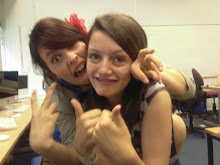As one of the main problems with the AS productions was the low sound quality, the media department invested in a boom mic. Unfortunately, due to weather and unavailability of the equipment, I was unable to use it in my production, and this did mean that my sound quality was compromised. In the worst effected sections I was able to use a portable digital audio recorder. which creates mp3 files that I was able to upload onto the computer and use to over-dub the pre-existing sound. It was fairly simple to use unlike the boom mic it doesn’t come with a dead cat that would reduce the background noise. However, it was a vast improvement on the other sound I had, so it was a good idea to use this equipment.
Sunday, 14 March 2010
Evaluation Part 4
As one of the main problems with the AS productions was the low sound quality, the media department invested in a boom mic. Unfortunately, due to weather and unavailability of the equipment, I was unable to use it in my production, and this did mean that my sound quality was compromised. In the worst effected sections I was able to use a portable digital audio recorder. which creates mp3 files that I was able to upload onto the computer and use to over-dub the pre-existing sound. It was fairly simple to use unlike the boom mic it doesn’t come with a dead cat that would reduce the background noise. However, it was a vast improvement on the other sound I had, so it was a good idea to use this equipment.
Evaluation Part 3
Throughout my production I have been continually getting audience feedback so that my product could be as sucessful as possible.
- Due to my initial anamatic not proving popular with the focus group I had available (as it didn't have an interesting twist in it, a very important convention of short films) I decided to change my concept completely and merge it with a sinister cannibal story. When I ran this story past a selection of the target audience they were a lot more positive and so that is the one that I chose to develop.
- Once I had filmed my initial footage for the night time scene (the first scene that I filmed) I pieced it together in sequence and showed it to my media class [this rough cut can be found here]. They were able to give me good, useful audience feedback that I was able to use to improve the scene. They suggested focusing more on the arm shot, as it was difficult to see and needed highlighting, and also that I might want to draw out the ending a bit more as it was too abrupt. One person suggested showing some of his clothing discovered in the woods the next day by some passer-bys, and as other people agreed this would be effective I developed it.
- After I had filmed the internal scenes I pieced it together with the other footage and put the video on popular networking site Facebook. This was so that I could get an extensive range of feedback from my own age-group, as this is the target audience for my film. As I am friends with several media students on Facebook, I was able to get more technical advice, as well as general plot and aesthetic feedback from others. They suggested improving on the sound quality (which I did by adding in a voiceover when the girl speaks) and they provided suggestions for the type of music that I should use. One person suggested using the stereo to provide music and I developed this to produce the diegetic soundtrack that I settled on.
- Taken from the inital audience feedback I changed the shot of the arm
and then added an extra section at the end, including fading titles (a common feature in many short films I researched) and a panning shot of the woods floor coming to rest on the male characters show that has been discarded. At this point I also had a soundtrack which I put on the footage. I then posted this new rough cut on Facebook to recieve more feedback.
From this audience feedback I established that the soundtrack was popular, but the dance track at the start needed to be edited so that it wasn't quite so loud at the start. I then had the idea to make the music diegetic, growing louder and quieter depending where the camera was in relation to the stereo, and then cutting off when the door shut. Many people thought this was a good idea so I used it.
- At this point I had pretty much finished my editing, but I showed to my media class again to ensure that there wasn't anything else I could do to improve it in the time left. My media teacher suggested that I needed more exposition at the start that shows the relationship between the two characters, but then members of my target audience said that the begining was the right length, if not a little too long. As they were my target audience I decided to keep it the length it was. It was also suggested that I could add some foreshadowing about the cannibalism, either by including someone eating some meat in the background, the characters walking past a butcher shop, or some sort of poster in the background. Had I had the time to reshoot the scene, I wanted to put a large "Meat is Murder" poster behind the two girls as they enter, as in this film eating meat does actually invovle murdering a human being. Unfortunately I ran out of time and resources and was unable to include that.
- Also using the networking site Facebook I was able to publish my film posters and get audience feedback on them. They proved to be popular, and although it was suggested that I should take out the rating and BBFC mark, I felt that it would be sensible to keep these in as they are both common conventions of promotional film posters. It was because of comments on these Facebook pages that I decided to create extra posters and a DVD cover, so audience feedback played a crucial part in that decision.
Evaluation Part 2
Short films are generally anywhere between 3 and 15 minutes long, but I found most were within the 4 to 6 minute bracket. Therefore I made sure that my film fit within this time scale so that it conformed to this general rule. It lasts roughly 5 ½ minutes, so fits comfortably.
My characters develop conventions of not only short films but television dramas and blockbuster films too. My female character, who remains nameless, was based on Effy Stonem from the Channel 4 drama Skins, although the stereotype of mysterious,
In Masque I’m challenging the stereotypical gender roles. Generally the girl would be shy and reserved, with the boy being the confident one that commands their attention, but I chose to reverse it in this film. This is very like the relationship between Effy and Freddie in Skins at first, and that’s what I tried to imitate. I think that the shy male character would appeal to a female audience, as vulnerable men tend to do, whereas the strong, confident, sexy female character would attract the male audience.
My soundtrack both conformed and challenged conventions of the short films that I researched. The music in short films tends to be primarily to build the tension or enhance the mood of the moment, but for the first section I chose to have diegetic dance music coming from the stereo. I chose to do this to provide anchorage of the age-group of the characters, and also to provide a light-hearted atmosphere to contrast with the sinister one later on. It also allowed me to play around with lyrics, and I was able to time the girl looking into the camera with the word “night”

When researching horror shorts I noticed that the titles were often white text on a black background that faded in either midway through or towards the end. I found that after a particularly tense part of the action the titles faded in to produce most fear in the audience as they have to imagine what’s coming next. Therefore I decided that I would try and use this, and placed a fading black screen just after the cannibals descend on him.
 This also acted as a break between the night time scene and the final scene set in the morning.
This also acted as a break between the night time scene and the final scene set in the morning.
I sought to conventions in order to make my film stand out and be more interesting, although merely developed some as they had proved successful in other texts.
Evaluation Part 1
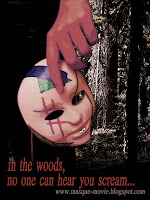
For all of the posters I focused on the two central protagonists and the cannibals, either represented by the masks or gathered by the fire. For the first poster I wanted to incorporate the masked characters to provide a link with my teaser poster. Although they were different masks, I think it is possible to associate the two images successfully. The second poster doesn’t feature the cannibals, but by laying the fire image over the picture of the girl I created a link between the two. As the girl is in the background of the image, looking at the boy, it establishes the link between them that makes up much of the film’s content. In the third promotional poster I focused on the girl only. I used a dramatic image that creates a sense of mystery about her, and this generates interest from the audience as to why she’s been singled out without any background or other characters. The final promotional poster I made is a staged image that is separate from the film itself. It features the central protagonist in the setting of a wood, tying in with the narrative, looking frightened. This will create a narrative enigma as to what he’s so afraid of. All of these posters will generate interest in the narrative. I think they have interesting overall images and entice the audience to watch the film.
Also to tie in with the teaser poster I included the same tagline in my promotional poster. Although some films have had different taglines for different promotions, (e.g. Nolan's The Dark Knight; teaser poster "Why So Serious?" and promotional poster "Welcome to a World Without Rules") I decided that the same tagline would provide more anchorage that the two posters were referring to the same film. I used the same font for the tagline as well, although made it different from the rest of the font on the poster. The billing block and “coming soon” were written in white, but the tagline and film title were a shade of orange that I took using the palate tool on Photoshop from the heart of the fire. The fire connotes danger and is a sinister source of light in the darkness, so this provides anchorage that my film is quite dark in nature and has a sinister plotline.
To tie in with the first teaser poster, I included the same tagline in my promotional posters. Although some films have had different taglines for different promotions, (e.g. Nolan's The Dark Knight; teaser poster "Why So Serious?" and promotional poster "Welcome to a World Without Rules") I decided that the same tagline would provide more anchorage that the two posters were referring to the same film. However, my teaser posters have differing taglines (“In the woods, no one can hear you scream” “Every rose has its thorn”  “She had his love, she wanted his heart”) in order to provide variety and spark more interest. I used the same font for the tagline in all posters, although made it different from the rest of the font on them. The billing block and “coming soon” were written in white, but the tagline and film title were a shade of orange that I took using the palate tool on Photoshop from the heart of the fire. The fire connotes danger and is a sinister source of light in the darkness, so this provides anchorage that my film is quite dark in nature and has a sinister plotline.
“She had his love, she wanted his heart”) in order to provide variety and spark more interest. I used the same font for the tagline in all posters, although made it different from the rest of the font on them. The billing block and “coming soon” were written in white, but the tagline and film title were a shade of orange that I took using the palate tool on Photoshop from the heart of the fire. The fire connotes danger and is a sinister source of light in the darkness, so this provides anchorage that my film is quite dark in nature and has a sinister plotline.
My magazine article followed the conventions of a film article that I discovered during my research. I was careful not to divulge the entire plot, as this would make the actual film obsolete, 
I kept the formatting of my article very 
 editing the footage and the actors reading through the script to show the full production of the film rather than just the finished product. On the first page I had a large image of the girl covering her face in accordance with the research I had carried out on magazine formatting.
editing the footage and the actors reading through the script to show the full production of the film rather than just the finished product. On the first page I had a large image of the girl covering her face in accordance with the research I had carried out on magazine formatting.
 I also created a DVD cover for my film, using the same image as my fourth promotional poster as the central image. I think that I stuck to the conventions of DVD cover formatting accurately and produced a cover that looks genuine and would entice the audience to buy the film. I included a review from a well-established film magazine, Total Film, to draw in the part of the target audience who read it, and to show that the film is worth watching. I think the text on the back cover could do with some tweaking to sell the film more efficiently, but the overall product does a good job of advertising the film.
I also created a DVD cover for my film, using the same image as my fourth promotional poster as the central image. I think that I stuck to the conventions of DVD cover formatting accurately and produced a cover that looks genuine and would entice the audience to buy the film. I included a review from a well-established film magazine, Total Film, to draw in the part of the target audience who read it, and to show that the film is worth watching. I think the text on the back cover could do with some tweaking to sell the film more efficiently, but the overall product does a good job of advertising the film.
Saturday, 13 March 2010
Ancillary Task (DVD cover) - Final Draft.
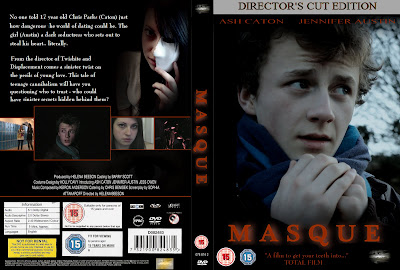
This is the DVD cover that I created. I tried to keep to the codes and conventions that I listed when doing the research into DVD covers.
 The image on the front of a DVD cover has to be eye-catching and interesting, as well as provide some exposition to the genre and narrative of the film. I chose the image from one of my promotional posters, of the central protagonist in the woods being afraid of the cannibals in the trees behind him. As already said in the poster series post, the cannibals didn't show up in the photograph, so I chose to cut down the image so the boy was central. I applied a blue tint over the image to create greater contrast between it and the text, but also to signify sombreity. A blue tint also has supernatural conntations, which ties in with cannibalism in the narrative. Although cannibalism isn't strictly supernatural, the blue tint signifies that something's wrong.
The image on the front of a DVD cover has to be eye-catching and interesting, as well as provide some exposition to the genre and narrative of the film. I chose the image from one of my promotional posters, of the central protagonist in the woods being afraid of the cannibals in the trees behind him. As already said in the poster series post, the cannibals didn't show up in the photograph, so I chose to cut down the image so the boy was central. I applied a blue tint over the image to create greater contrast between it and the text, but also to signify sombreity. A blue tint also has supernatural conntations, which ties in with cannibalism in the narrative. Although cannibalism isn't strictly supernatural, the blue tint signifies that something's wrong. The title on the front cover is in bright, bold, orange letters. These stand out from the black background that it's on, meaning the film's name is instantly visable. The colour and burnt effect tie in with the fire in the narrative, and as it's the same as in the posters they link together as a promotional package.
The title on the front cover is in bright, bold, orange letters. These stand out from the black background that it's on, meaning the film's name is instantly visable. The colour and burnt effect tie in with the fire in the narrative, and as it's the same as in the posters they link together as a promotional package. In every DVD cover that I researched there was a series of still shots on the back cover. I chose some of the key shots from the film; the girls' first entrance, when Chris first meets the girl, when the girl looks up into the camera, and when the cannibals are first seen. I surrounded them with orange outlines to make them stand out, and I enlarged the one
In every DVD cover that I researched there was a series of still shots on the back cover. I chose some of the key shots from the film; the girls' first entrance, when Chris first meets the girl, when the girl looks up into the camera, and when the cannibals are first seen. I surrounded them with orange outlines to make them stand out, and I enlarged the one  involving Chris to signify that he's the central protagonist that the narrative is based around.
involving Chris to signify that he's the central protagonist that the narrative is based around.On the back cover is a picture taken from the second teaser poster. It shows the girl appearing out of the darkness holding a mask to her facing, signifying that she's hiding part of her personality (the cannibalistic part). This fits with convention as the image at the top of the back cover is generally a staged one seperate from the film. This image will also generally be quite dramatic, as it will help encourage the audience to buy the dvd.
 On DVD covers at the bottom there is a section given over to ratings, information, barcode and the billing block. I tried to recreate this as accurately as possible, using the BBFC and film censorship ratings used on actual covers. I observed the layout that this section of the cover takes and tried to recreate it to ensure the cover looked as genuine as possible.
On DVD covers at the bottom there is a section given over to ratings, information, barcode and the billing block. I tried to recreate this as accurately as possible, using the BBFC and film censorship ratings used on actual covers. I observed the layout that this section of the cover takes and tried to recreate it to ensure the cover looked as genuine as possible. On the spine of the DVD cover I have included the production logo, the title, BBFC rating, serial number and the DVD video logo. These are all commonly found on the spines of DVD covers.
On the spine of the DVD cover I have included the production logo, the title, BBFC rating, serial number and the DVD video logo. These are all commonly found on the spines of DVD covers. Although a very minor part of my DVD cover, I have included a hologram of my production logo. These appear on DVD covers to help prevent copyright fraud, and so are important to remember.
Although a very minor part of my DVD cover, I have included a hologram of my production logo. These appear on DVD covers to help prevent copyright fraud, and so are important to remember. Some DVD covers (although not all) include a quote from a review of the film. As my promotional posters included a rating from Total Film, I decided to use this well-established film magazine as my source. The quote reads "A film to get your teeth into," which is a pun on the cannibalistic theme.
Some DVD covers (although not all) include a quote from a review of the film. As my promotional posters included a rating from Total Film, I decided to use this well-established film magazine as my source. The quote reads "A film to get your teeth into," which is a pun on the cannibalistic theme. On nearly every single DVD or VHS back cover is a synopsis of the film, along with further information about the actors or director. I put this in white on a black background to make it stand out (and also bring out the mask) and shaped the text to fit around the shape of the girl's body.
On nearly every single DVD or VHS back cover is a synopsis of the film, along with further information about the actors or director. I put this in white on a black background to make it stand out (and also bring out the mask) and shaped the text to fit around the shape of the girl's body.I also included a Director's Cut Edition banner at the top of the front cover, and the actors names in capital letters below it.
I think that my DVD cover looks genuine and works well with the other ancillary tasks that I've done.
Thursday, 11 March 2010
Ancillary Task (poster series) - Final Drafts.
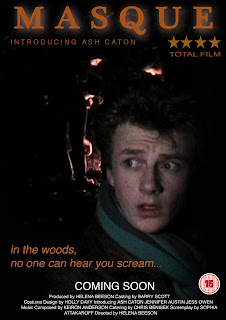
This is my original promotional poster. I then created several other posters to make up a promotional package.
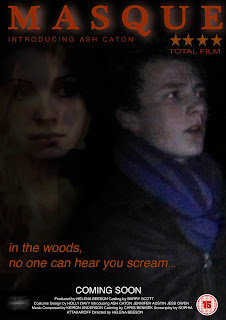

This is the third poster in my series
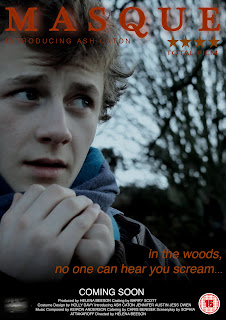
This is the final promotional poster that I came up with. I based
TEASER POSTER SERIES










